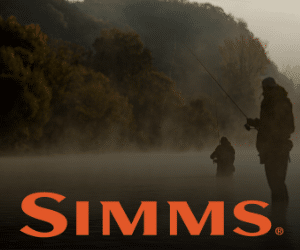Fly fishing hatch is probably one of the most productive means of catching fish. Bugs are all over the water and the trout are rising to the top to go eat them. But how does one identify if they have found a hatch or not?
It’s about as simple as it sounds.
How To Identify a Hatch
- How To Find a Hatch
- Transformation of Flies in a Hatch
- How to Fly Fish a Hatch
- When do Hatches Occur
- Fishing Without a Hatch
How To Identify a Hatch
The first step in identifying a hatch is, get out when the water temperature is starting to rise. If you find an area where there are a bunch of flies on the water, you have probably found a hatch. Flies start transforming from a pupa to an adult when the water temperature is starting to heat up. So if it’s been warm and the flies are everywhere, it’s probably a good idea to setup your fly rod and get fly fishing because you most likely have landed a hatch!
Finding a Hatch
Just start moving down the river until you find an area where the flies are starting to bunch up. Caddis Flies, Mayflies and Pale Morning Dun Flies are all different types of flies that will have hatches. There are obviously more flies, but those are some of the popular ones.
When a hatch is happening, the trout will be moving towards the top of the water and you are going to see a lot of flies floating on the water.
Flies will also be buzzing in the air above the water – they’ll basically be everywhere. If you look from a distance, you will probably see trout swooping up to the top of the water to grab a fly or two here and there. This is when you know that you’ve identified a hatch.
Transformation of Flies in a Hatch
Basically what is happening, in fly fishermen terms – is that flies are transforming from a pupa fly, to an adult fly. These flies will all gather in the same area which draws a lot of fish to the same spot. Hatches can last sometimes up to a couple weeks.
There are a lot of moving parts about what time of day that flies will start to hatch. Some say the best time of day is going to be in the morning, and maybe in the afternoon. Others say when the sun is starting to get dim. When talking about fly fishing during a hatch, anything is a possibility. The weather, sunshine, temperature, and water temperature are all going to affect how busy or not hatch will be.
If you are looking for the best answer I can give you, which has worked for me in the past – is days that are overcast with water temperatures around the 50’s. It’s usually around the afternoon time, lasting for a few hours. This is not every single time however and it is surely going to change with the different species of flies that are hatching.
There is no real or right answer here though. That’s one of the great things about fly fishing, it can go from hot to not in a minute, or the other way around. The best thing that you can do, is to ask around in your area about hatches, or get out yourself.
Bottom line although, the transformation of flies during the hatch is pretty simple and complex at the same time. One thing is for sure, hatches can be very productive.
Now in saying that, this does not mean that just because you find a hatch that you are going to catch a ton of fish! Sometimes, the trout will eat what they want to eat, and if you are not giving them what they don’t want to eat – you have to be constantly mixing up your fly.
How To Fly Fish a Hatch
Fly fishing hatch might seem like “oh just sauce something on the line and let’s go!” when actually it should be taken with a more detailed approach. There was an awesome tutorial over at Orvis where the instructor actually said to pick up a fly off of the water and take a good look at it. Then go to your fly box and find a fly that resembles the one you picked out of the water, the most. Throw that fly on your line and see what happens. This was actually probably one of the better fly fishing tips I’ve heard of, while fly fishing and identifying hatches.
If you find a hatch with a bunch of Caddis Flies, start using a Caddis Fly. If that doesn’t work however, change it up again. If the water temperature is right and the fish aren’t biting your fly – you are wasting time fishing with that same fly. Sometimes, that one killer fly just isn’t the move.
You might find a hatch one day and not catch more than three fish the entire time, sometimes that’s just how the cookie crumbles. If that’s the case, you must look back and ask yourself “how many times did I change my fly?”… because if you only changed it three times, using a slightly different variation of the popular Parachute Adams, that might be why.
See I love the Parachute Adams fly, it’s actually one of my favorite flies that I fish for trout with – but when it’s not working, it’s not working. It doesn’t matter, some days are going to be better than others. The only thing that I can suggest for you is to keep changing your flies up and using different variations of flies that are already on the water – until you get some trout to bite.
When Do Hatches Occur?
A hatch usually occurs in the Spring, when the water starts to heat up a bit. Depending on the location of where you will be fly fishing however, the hatch can happen at different times. If you are fishing in Minnesota, you might be getting a later hatch – when the water warms up a bit. If you are fly fishing an area that has warmer temperatures throughout the year, you might see more hatches early in the season. It all depends on the location of your where you are fishing.
In all honesty the only way to find out whether the hatch is happening in your area is to get on the water for yourself. That is going to be the most reliable source.
Like I said earlier also, talk to other fly fishermen or women in your area to find out what it happening on the water. It’s a really good resource. Or otherwise join fly fishing facebook groups in your area and start asking around. You’ll most likely find what you are looking for quickly.
But otherwise, I highly recommend just grabbing some of your favorite dry flies and getting on the water. A little break from the real world doesn’t hurt anyone, even if the hatch isn’t going on.
Fishing Without the Hatch
Fishing during a hatch can be very lucrative for you. But don’t let the fact that there might not be a hatch in the area stop you from going fly fishing. Fly fishing a hatch doesn’t guarantee success, just like fly fishing regular trout streams don’t guarantee success.
The fish are still going to be in the water regardless of what time you go fishing at. That’s just the bottom line.
And a little side note about fishing with dry flies when the hatch isn’t going on. You can still use them! They still work! Sometimes fly fishermen will put away the dry flies and start pulling out the streamers and nymphs – even though the dry fly can still be very productive throughout the summer!
At the of the day…
Fly fishing a hatch is very fun – when you have found the fly that the fish are biting. When you identify a hatch, find the right fly and put on a good show for the trout – you will have success. The best ways to learn whether or not your area has flies in a hatch, is to get on the water. Find out where the fish are hanging out and go catch em.
Even if you are fishing without a hatch in your area – you can still have success. This should be obvious, but sometimes fly anglers are very focused on fishing the hatch. Yes, it’s great. Yes, you can catch a lot of fish. But yes, you can still catch fish throughout the year, regardless of whether the hatch is going on or not!
I hope that this article helped you out, best of luck my friend and tight lines!


